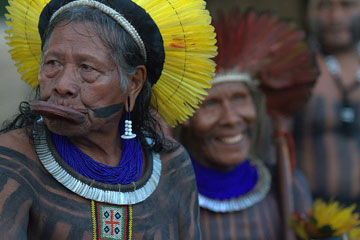As one arm funds destruction of indigenous lands via the Belo Monte Dam, another supports indigenous projects.
At the same time it is funding a dam that will devastate indigenous lands and block the Xingu River, Brazil’s National Development Bank (BNDES) may allocate some $14.3 million (BRL 22.3 million) in grants for projects developed within the Kayapo indigenous lands, reports Conservation International.
Earlier this week BNDES approved the creation of the Kayapo Amazon Fund to support indigenous-led projects to promote sustainable use and management of five ethnic Kayapo reservations: Kayapo Bau, Menkragnoti, Badjonkôre Jarina and Capote in southern Pará and northern Mato Grosso. The reservations are home to approximately 7,000 indigenous Kayapo.
The Kayapo Amazon Fund will also support environmental monitoring of indigenous territories.
 Chief Raoni of the Kayapoi has spent 30 years fighting the Xingu River. Photo courtesy of Amazon Watch. |
The fund will draw from the Amazon Fund, a Brazilian government initiative that aims to conserve and sustainably manage the Amazon. The Amazon Fund, which aims to raise nearly $20 billion in foreign donations over roughly the next, has so far dispersed $139 million (BRL 217 million) across 17 projects.
The Amazon Fund is managed by BNDES, a government-owned bank with more than $300 billion in assets. BNDES is the lead funder of the controversial Belo Monte dam, a project that will flood more than 40,000 hectares of forest and displace over 20,000 people in the same watershed occupied by Kayapo groups.
The Kayapo have been among the most ardent opponents of the dam.
Related articles
Deforestation in Brazil’s Amazon continues to rise; clearing highest near Belo Monte dam site
(06/17/2011) Deforestation in the Brazilian Amazon continued to rise as Brazil’s Congress weighed a bill that would weaken the country’s Forest Code, according to new analysis by Imazon.
Last chance to see: the Amazon’s Xingu River

(06/15/2011) Not far from where the great Amazon River drains into the Atlantic, it splits off into a wide tributary, at first a fat vertical lake that, when viewed from satellite, eventually slims down to a wild scrawl through the dark green of the Amazon. In all, this tributary races almost completely southward through the Brazilian Amazon for 1,230 miles (1,979 kilometers)—nearly as long as the Colorado River—until it peters out in the savannah of Mato Grosso. Called home by diverse indigenous tribes and unique species, this is the Xingu River.

(06/03/2011) As an American I know a lot about shame — the U.S. government and American companies have wrought appalling amounts of damage the world over. But as an admirer of Brazil’s recent progress toward an economy that recognizes the contributions of culture and the environment, this week’s decision to move forward on the Belo Monte dam came as a shock. Belo Monte undermines Brazil’s standing as a global leader on the environment. Recent gains in demarcating indigenous lands, reducing deforestation, developing Earth monitoring technologies, and enforcing environmental laws look more tenuous with a project that runs over indigenous rights and the environment.







